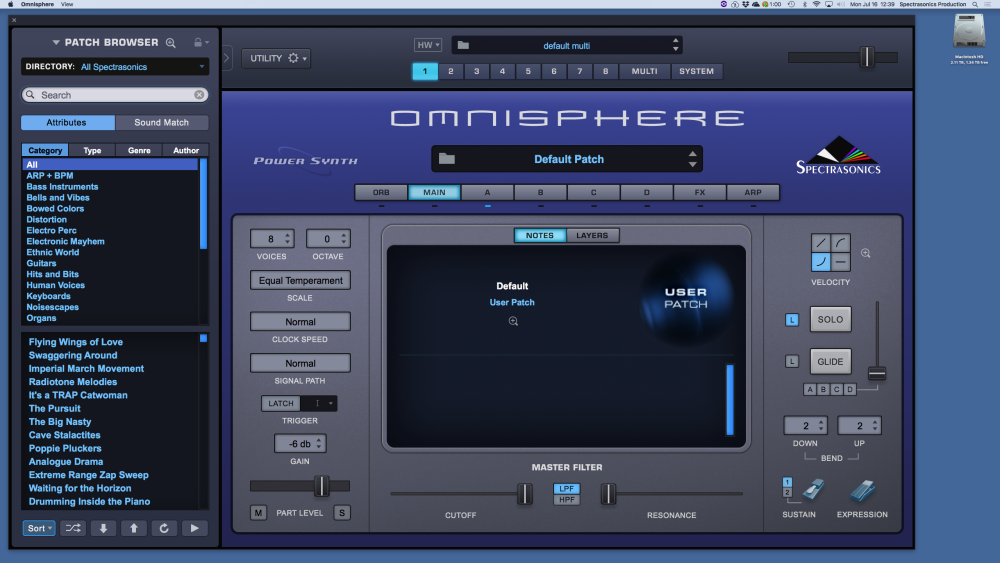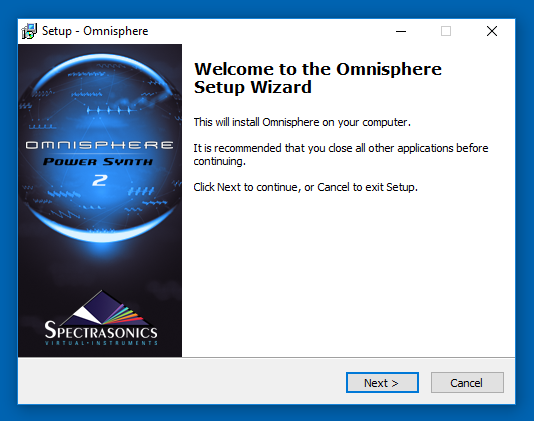Omnisphere 2 Free Download Crack. Download from the links below. Extract the archive with the Winrar software on your PC. Run the setup.exe file from the extracted files. Continue the installation until it is installed; close the program and run it again. Finished; enjoy the free full version. Omnisphere 2 Vst Crack Download. KVR Audio Forum - Omnisphere PC Requirements - Instruments Forum. Once the Download Manager completes its data–grabbing, installation proceeds as a call and response system, after which Omnisphere 2 can finally boot. I was immediately directed to pick up an updated version (2.0.2c, and about a week later 2.0.2d) to reflect the small fixes made as OS2 spreads to a wider audience.
- Omnisphere 2 Installer
- Mediafire Omnisphere 2 Download
- Omnisphere 2.6 Crack Torrent
- Can My Laptop Run Omnisphere 2019
MAC INSTALLATION GUIDE CAN BE FOUND HERE:
The required specs specify 2.4 GHz. I have the required 8 gb of ram. Can I run omnisphere on my 2.3 GHz dual core i5 MacBook Pro? When one vst is worth more.
GETTING STARTED - Windows USB Drive Installation
Follow this set of instructions to install Omnisphere 2 from your USB installation drive on to your Windows system.
Note: You'll need over 64GB of free space available on your hard drive in order to install the instrument.
Omnisphere 2 Installation
Step 1: Connect the Omnisphere installation drive to a USB port. Open the drive 'Spectrasonics Omnisphere' and double-click the file 'Omnisphere 2 Installation.url.'
Step 2: Log in to your Spectrasonics user account and select the 'DOWNLOAD' button to download the current installers to your PC.

Step 3: From your Downloads folder, open the 'Omnisphere_2_Installation' folder, then open the 'Step 1 - Installer' folder.
Step 4: Open the Windows folder inside of 'Step 1 - Installer.' Double-click 'Omnisphere 2 Installer.exe' to begin the installation of Omnisphere 2.
Step 5: Follow the steps as you're guided through the installation process. Make sure to review the Installation Info and Licensing FAQs and accept the license agreement.
Step 6: At the “Select Components” step, you'll choose to install the 32bit and/or 64bit versions of Omnisphere. If you are uncertain which one to choose, select them both. The following steps will show you the default location for both versions of the VST.
Step 7: The default location of the large Omnisphere data files will be displayed next. If you wish to install the core library to a secondary drive, click the 'Browse' button to choose a different location.
Step 8: Once the installation paths have been confirmed, the installation will begin.
Step 9: After the installation is complete, select 'Finish.'
Step 10: From your Downloads folder, re-open the 'Omnisphere_2_Installation' folder, then open the 'Step 2 - Data Updater' folder.

Step 11: Run the 'Omnisphere 2 Data Updater.exe.'
Step 12: Make certain that the Omnisphere 2 Data Updater selects the correct STEAM folder.
Step 13: When the update has been installed, select 'Finish.” Now it's time to open Omnisphere 2 in your host and authorize it.
In just the past several decades, music production has moved from exclusively analog (magnetic tapes and mechanical devices) to being almost fully reliant upon digital technology (computers). So much music is produced today with the aid of computers that a generation has grown up knowing nothing else. 8-tracks and cassette tapes have been replaced by Pro Tools and hard drives. With computer speed and capacity increasing and size decreasing, musicians are turning from traditional instruments to laptops for convenience, portability, and reproducible sound quality.
A brief history of my musical life
My family had a console piano that I learned to play on growing up. The “nice” keyboards and synthesizers were not new technology but were still expensive. I had a Yamaha PSR-6 keyboard that opened up an entirely new realm of musical possibilities to me. With onboard rhythms and an assortment of various sounds, I began to write basic 4-chord songs that I thought were pretty good at the time.
I started experimenting seriously with computer-based music production in 1995 when I bought a Sound Blaster AWE32, a sound card for my PC that had several megabytes of onboard samples rather than sounds synthesized by an FM chip. With Cakewalk Professional on Windows 95 I wrote many songs, from basic piano pieces to techno with the emulated TR808 drumkit. I would always be looking for new MIDI files to download from the internet to see how well they sounded on my new Sound Blaster card.
In 2002 I purchased a Korg Triton Studio, a 76-key music production synthesizer. It was by far the best sounding keyboard I had ever owned. The Triton is still a top-notch keyboard today. But I ended up selling it several years later because of the advantages I saw in using software over a hardware solution.
While working for a large tech company in 2004, I purchased my first Mac laptop. It wasn’t until moving to Kansas City in late 2004 that I began to experiment with live production on a laptop. After purchasing Ableton Live and Propellerhead Reason in late 2004, I began to use it on stage for my sets for the versatility of its sound and portability of the entire rig (over a massive keyboard).

What do you use on stage for your sets today?
The hardware I am currently using is an Apple MacBook Pro with 4GB of RAM and an upgraded 7200 RPM hard drive. I’ve found that the 7200 RPM drive is very helpful in providing faster loading time of samples, especially when I have a lot of sound already playing back. I use a MOTU Ultralite firewire audio interface to connect the Mac to the sound system. I also have a Akai APC40 MIDI controller to control Ableton Live in realtime so I don’t have to use the Mac’s trackpad or a mouse to control instrument parameters.
Software
Ableton Live
I currently use Ableton Live 8 as my main DAW on stage. In addition to being suited specifically for live performance in looping and mixing audio clips, Live can host virtual instruments and has a plethora of effects and presets.
Screenshot of audio tracks and loop setup
Each track is set up to use a specific instrument, and I load all of the instruments I commonly use in sets to be able to access them quickly. I’ll often add tracks or just replace an instrument on a track if I want something different that I haven’t already loaded. I’ll just use the track’s “arm” button to switch between instruments as I’m playing.
As you can see, I have many pre-recorded loops (that I make ahead of time) that I can recall at a moment’s notice depending upon where we go musically in our set. I’ve taken the “one large Live set” approach as opposed to “multiple small sets” simply because I can’t quit Live and load a new set in the middle of a spontaneous musical time.
Check out Ableton’s site for more information, tutorials, and tips for using Live.
Recommended Ableton Live training books and media:
Ableton Live 8 Power!: The Comprehensive Guide
Ableton Live 8 and Suite 8: Create, Produce, Perform
Ableton Essential Instruments Collection 2
An addon specifically bundled and constructed for Live, the EIC2 adds a great sounding, not-so-resource-intensive grand piano sample that I use extensively. I also use some of the EP and organ sounds from EIC2, but a majority of the sounds I use on sets come from the extremely powerful Spectrasonics Omnisphere.
Check out EIC2 here.
Spectrasonics Omnisphere
Although I use more in the studio, Omnisphere is the backbone of the sonic possibilities with my live rig. From traditional pads, strings, and synth instruments to more exotic samples like ethnic instruments and voices. I don’t want to give an entire tutorial of Omnisphere here, but suffice it to say that it’s totally worth the money!
Some of my favorite stock patches that I use live:
Plucking the Piano Harp
Brutal Megalomaniac
Adagio Transparent Strings
Big Green Strings (originally from Atmosphere, Omnisphere’s predecessor)
Glorious Guitars
I also have many many custom made patches that make up my sound collection that I use often. I’ll let you try to figure those out yourself.
Omnisphere 2 Installer
Check out Omnisphere here.
Quantum Leap Ra
Quantum Leap Ra is a plugin that provides me with lots of ethnic instruments, from Middle Eastern strings to the Bongos, Bansuri, and Banjo. I’ll use these instruments sparingly so that when I do use them they really add a unique sound to the band.
Find more info on Quantum Leap Ra here.
Mediafire Omnisphere 2 Download
Propellerhead Reason
I no longer use Reason as part of my live rig, but I figured it was worth mentioning. I used to run Reason rewired to Live, having a MIDI track for each instrument I wanted to play in the Reason rack, and one Audio track set to receive audio from Reason through rewire. The downside of this setup was that I had to map individual faders on my controller to Reason’s mixer, and I couldn’t control the volume of each instrument directly from Live without having a separate audio track for each corresponding MIDI track.
Demo video
Here is a little video I made back in 2010 demonstrating the power of Ableton Live in a worship meeting with only a worship leader and myself.
If the video fails to display, you can view it here: http://www.youtube.com/watch?v=E2X2JA47dhc
Where can I buy the gear you have?
Laptop:
Apple MacBook Pro
Find the best laptop for you
Audio interface:
MOTU Ultralite
See other audio interfaces
Surface controller:
Akai APC40
See other MIDI controllers
DAW software:
Ableton Live 8
See other DAWs
Virtual instruments:
Spectrasonics Omnisphere and Quantum Leap RA
See other virtual instruments
More recommended gear
Interfaces
Laptops
Controllers
DAWs
Software
Omnisphere 2.6 Crack Torrent
Questions?
I don’t have time to give you lessons on how to use all these programs over email, but I can try to answer any specific questions about my setup you may have. Just contact me.
If you've been blessed by Josh's music or by this page, consider donating to his ministry: